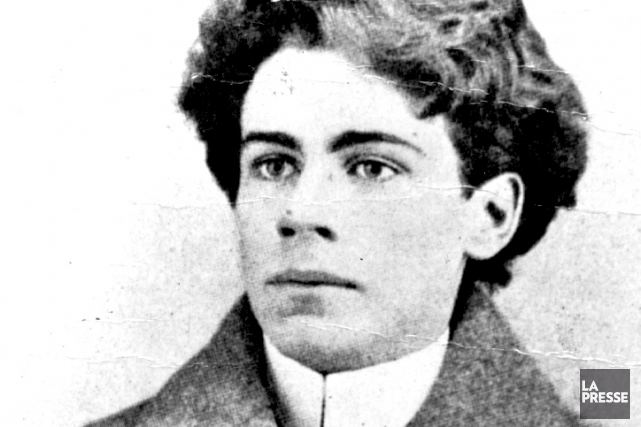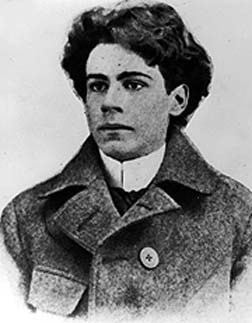Name Emile Nelligan | Role Poet | |
 | ||
Education College Sainte-Marie de Montreal Books Poésies complètes, Emile Nelligan et son œuvre People also search for Roseline Granet, Frederic Chopin, J. Scott Brubacher | ||
clair de lune intellectuel de mile nelligan lecture de po mes poetry reading
Émile Nelligan (December 24, 1879 – November 18, 1941) was a francophone poet from Quebec, Canada.
Contents
- clair de lune intellectuel de mile nelligan lecture de po mes poetry reading
- soir d hiver de mile nelligan poetry reading lecture de po mes english sbt
- Biography
- Le Vaisseau dOr
- Christ en Croix
- Tribute
- Musical adaptations
- References
soir d hiver de mile nelligan poetry reading lecture de po mes english sbt
Biography

Nelligan was born in Montreal on December 24, 1879 at 602, rue de La Gauchetière (Annuaire Lovell's de 1879). He was the first son of David Nelligan, who arrived in Quebec from Dublin, Ireland at the age of 12. His mother was Émilie Amanda Hudon, from Rimouski, Quebec. He had two sisters, Béatrice and Gertrude.

A follower of Symbolism, he produced poetry profoundly influenced by Octave Crémazie, Louis Fréchette, Charles Baudelaire, Paul Verlaine, Georges Rodenbach, Maurice Rollinat and Edgar Allan Poe. A precocious talent like Arthur Rimbaud, he published his first poems in Montreal at the age of 16.

In 1899, Nelligan suffered a major psychotic breakdown from which he never recovered. He never had a chance to finish his first poetry work which - according to his last notes - he would have entitled Le Récital des Anges.
At the time, rumor and speculation suggested that he went insane because of the vast cultural and language differences between his mother and father. In recent years, however, a number of books and biographical films, including Robert Favreau's 1991 biopic Nelligan, have postulated that Nelligan was gay. Some of these sources suggest that he became mentally ill due to inner conflict between his sexuality and his religious upbringing, while others suggest that he never went insane at all, but was involuntarily committed to the asylum by his family for homophobic reasons. No biographical sources published during Nelligan's lifetime contain any confirmed record of Nelligan having had any sexual or romantic relationships with either men or women, although some posthumous sources have suggested that he may have been the lover of poet Arthur de Bussières. Within the École littéraire de Montréal circle with which both Nelligan and Bussières were associated, it was widely believed that Nelligan was confined to the asylum because his mother discovered him and Bussières in bed together, although this claim was not widely publicized until the late 20th century and remains unconfirmed.
In 1903, his collected poems were published to great acclaim in Canada. He may not have been aware that he was counted among French Canada's greatest poets.
On his passing in 1941, Nelligan was interred in the Cimetière Notre-Dame-des-Neiges in Montreal, Quebec. Following his death, the public became increasingly interested in Nelligan. His incomplete work spawned a kind of romantic legend. He was first translated into English in 1960 by P.F. Widdows. In 1983, Fred Cogswell translated all his poems in The Complete Poems of Émile Nelligan.
Nelligan is considered one of the greatest poets of French Canada. Several schools and libraries in Quebec are named after him, and Hotel Nelligan is a four-star hotel in Old Montreal at the corner of Rue St. Paul and Rue St. Sulpice.
In her 2013 book Le Naufragé du Vaisseau d'or, Yvette Francoli claimed that Louis Dantin, the publisher of Nelligan's poems, was in fact their real author. This claim was also previously advanced by Claude-Henri Grignon in his 1936 essay Les Pamphlets de Valdombre, although Dantin himself denied having had anything more than an editing role in the poems' creation. In 2016, the University of Ottawa's literary journal @nalyses published an article by Annette Hayward and Christian Vandendorpe which rejected the claim, based on textual comparisons of the poetry credited to Nelligan with the writings of Dantin.
Le Vaisseau d'Or
Ce fut un grand Vaisseau taillé dans l'or massif:
Ses mâts touchaient l'azur, sur des mers inconnues;
La Cyprine d'amour, cheveux épars, chairs nues,
S'étalait à sa proue, au soleil excessif.
Mais il vint une nuit frapper le grand écueil
Dans l'Océan trompeur où chantait la Sirène,
Et le naufrage horrible inclina sa carène
Aux profondeurs du Gouffre, immuable cercueil.
Ce fut un Vaisseau d'Or, dont les flancs diaphanes
Révélaient des trésors que les marins profanes,
Dégoût, Haine et Névrose, entre eux ont disputés.
Que reste-t-il de lui dans sa tempête brève?
Qu'est devenu mon coeur, navire déserté?
Hélas! Il a sombré dans l'abîme du Rêve!
Christ en Croix
Je remarquais toujours ce grand Jésus de plâtre
Dressé comme un pardon au seuil du vieux couvent,
Échafaud solennel à geste noir, devant
Lequel je me courbais, saintement idolâtre.
Or, l'autre soir, à l'heure où le cri-cri folâtre,
Par les prés assombris, le regard bleu rêvant,
Récitant Eloa, les cheveux dans le vent,
Comme il sied à l'Éphèbe esthétique et bellâtre,
J'aperçus, adjoignant des débris de parois,
Un gigantesque amas de lourde vieille croix
Et de plâtre écroulé parmi les primevères;
Et je restai là, morne, avec les yeux pensifs,
Et j'entendais en moi des marteaux convulsifs
Renfoncer les clous noirs des intimes Calvaires!
Translation by Konrad Bongard
The gypsum Jesus always stalled me in my steps
Like a curse at the old convent door;
Crouching meekly, I bend to exalt an idol
Whose forgiveness I do not implore.
Not long ago, at the crickets' hour, I roamed dim
Meadows in a restful reverie
Reciting 'Eloa', with my hair worn by the wind
And no audience save for the trees.
But now, as I lie with knees bent beneath Christ's scaffold,
I see his crumbling mortar cross
With its plaster buried in the roses, and am saddened -
For if I listen close enough, I can almost hear
The sound of coal-black nails being wrung in
To his wrists, the savage piercing of Longinus' spear.
Tribute
Several schools and libraries of Quebec bear the name of Émile Nelligan. Since 1979 the Prix Émile-Nelligan has rewarded the authors of a French-language poetry book written by a young poet in North America.
On June 7, 2005, the Fondation Émile-Nelligan and the City of Montreal inaugurated a bust to his memory in the Carré Saint-Louis. Another monument to his memory stands in Quebec City.
The poetry of Nelligan inspired numerous music composers:
Musical adaptations
American classical composer John Craton utilized five of Nelligan's poems in the song cycle Jardin sentimental (2004).
